
Flying Vampires with 75 Squadron 1969 – 1970
My introduction to flying in Vampires with 75 Squadron (Sqn) began when I was posted to Ohakea in April 1966 as an 18 year old Secretarial Officer. At that time 75 Sqn aircrew were located in the north western corner of No 2 Hangar at Ohakea and the 75 Sqn Servicing Flight, together with all the Vampires, occupied No 1 Hangar. My first Vampire flight was on 16 June 66 in Vampire T11 NZ5711 with the Operations Flight Commander, Flt Lt ‘TT’ Trevor Bland. Trev flew a low level navigation exercise (navex) before firing 2 inch rockets (R/P) at D49 Raumai weapons range, which was out in the sand hill country on the coast near to Ohakea. I was mightily impressed! In July ’66 I flew in NZ5708 with Flt Lt John Denton doing hi level cine and battle formation. In October I flew with Fg Off John Woolford in Vampire T11 NZ5711 doing High level ‘Battle’ formations and some ‘tail chasing’ – which was great fun! In November I flew with Fg Off Arthur Dovey in NZ5707 doing Radar Pursuit Intercepts (PIs) and air combat – this was high ‘g’ stuff for an Admin officer! After the flight back at base, it seemed to me that whoever grabbed the chalk first in the aerial combat debrief was the ultimate winner. I had a second flight in November 1966 in NZ5707, this time with Fg Off Murray Whineray doing Radar PIs and a tail chase.
In January 1967 I flew with Fg Off Dave Bevan on a hi level navex – we went from Ohakea direct to Kaikohe, back to Napier, across to Waverley and home to Ohakea – a 2 hour 35 minute flight with drop tanks, and a mighty sore backside sitting on the Martin Baker Mk3B ejection seat where there always seemed to be sharp edge of a can of water from the survival pack right under a point of one’s bum. In April I flew in NZ5709 with Fg Off Geoff ‘Oop’ Oglivie on a 30 minute flight doing 45 degree dive bombing at Raumai – more hi ‘g’ and more punishment for a Secretarial Officer, and with no anti ‘g’ suits in those days! In June I had a 50 minute flight in 5711 with Fg Off John Woolford doing Radar PIs and a tail chase, and on 7 Aug 67 another flight with Murray Whineray in 07 doing Battle Formations. Sadly, Murray was killed the next day when his Vampire crashed on approach on Runway 09 at Ohakea after a formation aerobatic flight for the 485 Sqn veterans who had handed over their badge for use by Strike Wing. Fg Off Peter Waller took me in NZ5709 to Whenuapai to deliver some safe-hand documents on 29 Aug 67 and we returned to Ohakea on the same day. In October Sqn Ldr ‘BJ’ Barry Reid took me in 5707 for a 1 hour flight doing aerobatics followed by an NDB to PAR approach – hi tech stuff to me. My final Vampire flight was with CO 75 Sqn – Sqn Ldr Colin Rudd in NZ5709 who took me to Wigram on 31 Oct 67 to start my ‘Wings’ Course. Colin was leading the 75 Sqn Vampire Aerobatic Team to Wigram to participate in the ‘50th Anniversary of Flight’ airshow held at Wigram.
Posting to 75 Sqn in Jan 69 – Having completed my Wings Course at Wigram on Harvard and Devon aircraft, and the subsequent 4 month Operational Orientation Course (OOC) that followed, I was posted to No 75 Vampire Sqn in Jan 1969. Flt Lt Mafeking Baden Powell Pere took me on my first dual flight on 14 Jan 69 in Vampire T11 5711. After engine start he said “Where to do your parents live”? “Stratford”, I said. “OK, take me there”, he said. He called Air Traffic (Flt Lt Bruce Hargreaves) and said Vampire 77 taxi VFR to Stratford. And off we went, no planning or flight plan! This is a pretty different, way to operate, I thought. At Stratford he asked me to point out where my parents lived. We found the house, circled it a few times and then flew back to Ohakea. After landing he said, “Now that you have been, you don’t have to go back any more – too many do dumb things when they go and see their parents”. And so ended Conversion sortie number one in NZ5711. After that, Flt Lt Ken Gayfer taught me how to fly the Vampire. After five flights I had my first jet solo – in NZ5711, and two days later had my first solo in a single seater in FB5 NZ5776. Instrument flying then started, followed by navexs, night flying, low flying and hi battle formations. By mid February, 45 degree dive bombing began at Raumai, with 8 x 8.5 pound practice bombs, followed in early March with low level ‘skip’ bombing, again with 8 x 8.5 lb practice bombs. Next was 30 degree rocketry with 4×2 inch HVAR rockets carried on rails under the aircraft. In March, air-to-ground gunnery started with 20mm canon and on 21 March 67, I had a formal Squadron Commanders check with CO 75 Sqn – Sqn Ldr Ross Donaldson, before being posted to 75 Sqn Operational Flight.
After a month of ‘enforced’ leave to allow the 75 Sqn ‘Yellow Hammers’ aerobatic team to practice, my first flight on the ‘Op’ Flt was on 21 Apr 69 where I had a dual check in NZ5707 with Flt Lt Ken Gayfer. The next day I did solo 45 deg dive bombing and 30 deg rockets (RP) at Raumai in NZ5767 followed by some dual close formation in NZ5711. On 23 Apr 69 I had another dual flight in 07, this time to fly a ‘snake’ climb, hi battle formation, tactical descent and pairs PAR approach – probably to catch up on a few skills no taught on the Vampire conversion.
The Squadron with 10 Vampires deployed to ‘Exercise Kea Claw’ in New Plymouth (NP) on 29 April 69 and returned to Ohakea on 7 May 69. We set up a tented camp at New Plymouth and operated out of the short NP airstrip supporting a Forward Air Controllers (FAC) Course, including FAC controlled practice weapons at Raumai. At that time, the RNZAF was providing FACs to operate in the Vietnam War and the FACs needed to gain experience controlling real aircraft onto targets before being posted to serve for 6 months flying USAF FAC aircraft in Vietnam. At NP we also did anti shipping strikes, high and low level navexs and generally had a great time including parties each evening in the tented camp. I remember an Open Day airshow where the 75 Sqn ‘Yellow Hammers’ Aeros team gave a great show. I also recalled an earlier airshow held at New Plymouth a year or so ago when TT Bland scared the pants off the very big crowd as he came from behind them at hi speed and low altitude to start his solo display. As Jet Jocks, we junior guys thought we were “Kings of the Air”!!
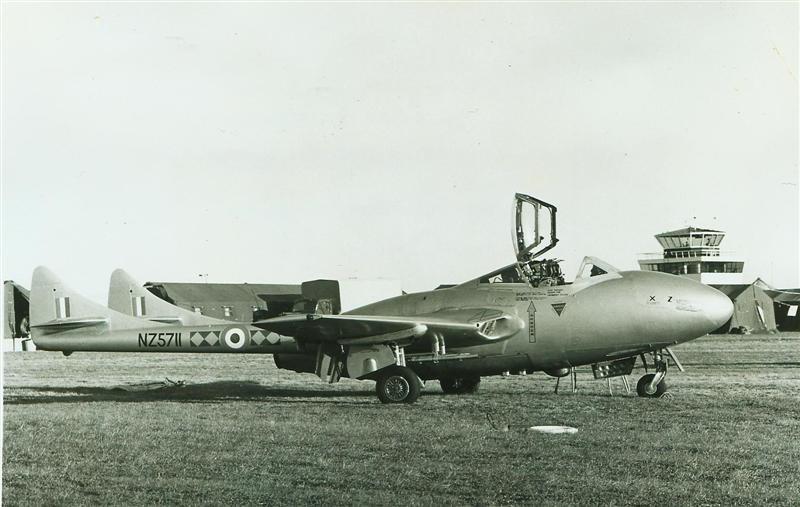
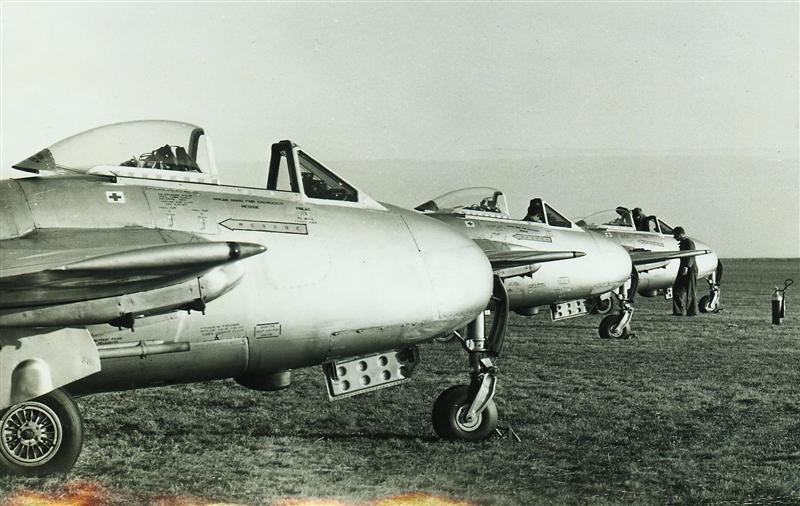
Back at Ohakea in June 67, Flt Lt Roger Henstock gave me dual flights in ‘Cine on the banner’ before progressing to solo air-to air 20mm gunnery on the banner. As junior officers (boggies), Fg Off Ken Cox and I went as Operations Officers supporting 14 Sqn Canberras to an air defence ‘Exercise Townhouse’ based in Darwin, Australia over the period 18-25 Jun 69 where we worked in the exercise evaluator’s air plotting room. Our beds were on a dirt ground floor under a raised barrack block and I remember waking on our first morning after a heavy night in the bar and sniggering at the massive mosquito bites on Ken’s face. He just looked at me and said “Take a look in the mirror at yourself! Those welts stayed with us for many days. What an exercise – raids by Vulcans and Canberras being attacked by RAF Lightnings and RAAF Mirages. Sunshine, swimming pools, rides in choppers to see massive crocodiles, Swan beer, Aussies and Poms. Quite a lot for a boggie Vamp pilot to take in.
Back at Ohakea I stared doing air tests in July and became a Flight Leader of 2 aircraft formations. By now, Sqn Ldr Donaldson had been posted to USA as an exchange officer with the US Navy to fly the A4 Skyhawks and our new CO was Sqn Ldr John Scrimshaw. John was, in January 1970, to lead the 10 RNZAF ‘Strike’ pilots to Florida, USA to convert to the new RNZAF AK Skyhawks. On the squadron, another FAC course was supported in September 1969.
On 30 Sep 69, 75 Sqn deployed 10 Vampires to Gisborne for ‘Exercise Golden Kiwi’. Operating from a tented camp on the Gisborne airfield we flew FAC Controlled strikes, bombing and rocket attacks on D34 Volkner Island (located alongside White Island off Tauranga/Whakatane), road recces and simulated strikes for the first week of the exercise.

One flight on 7 Oct 69 was a Diamond 9 practice flight where I was number 7 of 9 aircraft. On 8 Oct 69 we flew a Diamond 9 flypast over the arriving Cook Bi-Centennial Naval Armada – the multi-national fleet of ships coming to Gisborne to help celebrate the bi-centennial of Captain James Cook RN discovering New Zealand in 1769.
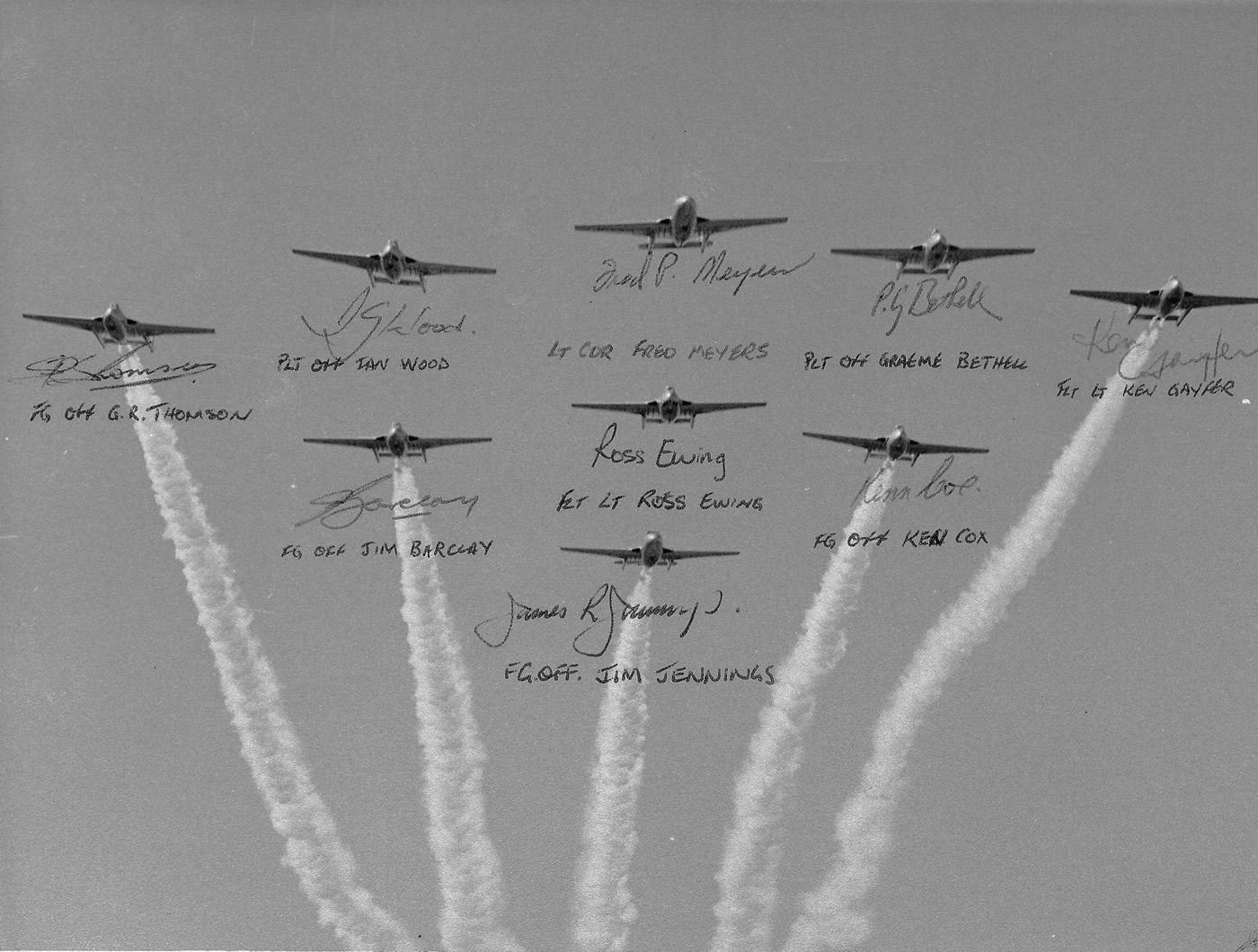
On the morning of 9 Oct 69, we flew a Diamond 9 flypast over the Civic Ceremony held at Endeavour Park that itself was located at the northern end of the main street in Gisborne. The Governor General, Sir Arthur Porritt and Lady Porritt, the Prime Minister Mr Keith Holyoake and Mrs Holyoake, The Mayor of Gisborne, Mr Barry Barker and Mrs Barker and other dignitaries had assembled. The flypast was timed to coincide with the Royal Salute before the Governor General inspected the Guard of Honour. Our Diamond 9 was lead by Lt Cdr Fred Myers, our USN exchange officer. Fred had had several practices the previous day in order to get his timing spot on for the run in from the holding point to be overhead the official dais on time. Fred said all was set for a high-precision, on-time flypast. On the day it proved to be precisely on time, and low. Fred had forgotten that with a Diamond 9 formation, he had Vampires stacked in two levels below him. And as Fred was low himself, guess what the lower aircraft were – me included. We generated white diesel smoke from the five rearmost aircraft in the formation and our CO, Sqn Ldr Scrimshaw was on the ground with the VIPs at the official parade. He later said that as soon as the mighty 75 Sqn 9 ship flew past, the official party were instantly covered in thick white smoke!
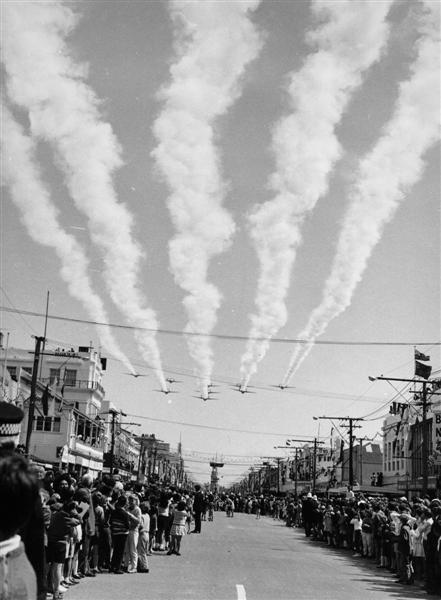
As the Diamond 9 passed by the official dais and headed, at very low altitude, up the main street of Gisborne, Fg Off Jim Jennings (who as number 9 in the Diamond 9 and was thus at the bottom rear of the formation), must have come really, really close to smashing into the model Captain Cook sailing ship that was mounted on top of a pole just beyond the clock tower in the main street. Having passed the clock tower, Number 6 in the formation, Flt Lt Ross Ewing asked of Jim Jennings “Are you still there 9?” Sqn Ldr Pat Neville, CO 14 Sqn, was a passenger in Jim’s aircraft and said later he tried to urge Jim to remain quiet and thus give plenty of cause for concern to Fred Myers! Pat also said he looked from his seat in the Vampire into the window of Hallensteins Men’s Wear in the main street and could see the pair of underpants he knew he would need after the flight!
On the afternoon of the same day we did another Diamond 9 flypast – this time for the official NZ Government function and ‘Beating of the Retreat’ held at Rugby Park in Gisborne. Fg Off ‘Iggy’ Wood was the Flypast Controller located at Rugby Park and his job was to radio the Diamond 9 formation leader, now Sqn Ldr John Scrimshaw, when the Governor General’s motorcade arrived at the entry gate to the Park. The formation was flying a wide circle around the Park at some distance away and ‘Scrim’ intended that when the call came from Iggy, he would turn in towards the Park and start the flypast. The time needed for the Vampires to reach the dais from the ‘circle distance’ was slightly longer than the time needed for the Governor’s motorcade to reach the dais and thus allow the Governor to get out of his car and mount the dais. However, one problem for Iggy was that a grandstand blocked his view of the main gate so he could not see when the Gov’s car reached the gate. He asked Flt Lt Randal Springer (formally a Radio Op on 75 Sqn Lancaster bombers late in WW2, and then an air traffic controller and SATCO at Ohakea) to stand at the end of the grandstand and when the motorcade arrived he was to raise his arm and signal to Iggy that the Gov was close. Iggy would then call the Flypast Leader to start the run in.
Well as the story unfolded a lady, seeing a man in uniform, asked Randal where the toilets were. “Over there,” said Randal pointing to the Toilet block. Iggy took this hand signal to mean the Gov had arrived and accordingly radioed Scrim. Beaut, thought Scrim, all is working to plan as the mighty 9 ship were called into close formation and started the run in for the flypast. A minute or so later Randal, seeing the Gov arrive at the gate signalled Iggy. Iggy was now totally confused and, realising his mistake, told Scrim to stop the run-in. Scrim tried his best to turn the formation, but aircraft split off like a roman candle as the big 9 ship tried to wheel away. A little later the Gov got a series of flypasts from Vampires trying catch up with the leader.
A Bi-Centenary airshow was held at Gisborne with a great display from participating aircraft. While doing his solo display Flt Lt Ross Ewing scooped out the bottom of his inverted run and, forgetting he was live on the public PA, part-time commentator a certain Fg Off Jim Barclay let out some ‘expletive deletions’ before Ross reappeared from behind the control tower. To prove it’s capabilities on 13 Oct 69, the 9 ship did a perfect fly by at Wairoa enroute from Gisborne to Ohakea at the end of the deployment.
Normal varied flying operations continued at Ohakea until Christmas 1969 including support sorties to No 6 FAC Course in early December. One of my last flights for the year involved flying a Vampire FB5 NZ5767 back to Ohakea from Woodbourne where a Mark 3 Goblin engine had been installed. The Mk 3 Goblin engine was normally fitted in a T11 Vampire and at 3200lb static thrust (at sea level) it had bit more thrust than the traditional FB5 Mk2 Goblin of 3100lb static thrust. It was late on Friday afternoon before the airplane was finally ready at Woodbourne and thinking this new ‘hot ship’ must surely have plenty of extra speed, I flew back to Ohakea fast and low. I ripped down the street between the Main gate at Ohakea and the Officers Mess pretty fast and low so the boys in the bar, having their standard Friday night session, would know I was home with my new alloy tailed wooden wonder. In my enthusiasm, I guess I had forgotten the big boss – OC Strike Wing, Gp Capt ‘Mo’ Moss, would be in the bar as well. After my heroic buzz ‘n break and when downwind to land, the Tower controller relayed a message to say, “That was pretty impressive but compliments from OC Strike Wing, he will see you in his office at 0800 on Monday morning”. Funny how I lost the urge for a handle or two at the bar, and I instead scuttled straight home to see my wife and new baby daughter! The weekend seemed to drag, and on the Monday morning I reported to and waited dutifully in the Strike Wing Adj’s office for some 50 minutes beyond 0800. After my sweaty-palm wait, and on cue, the Adj then opened a note from the Big Boss to say he was away for a few days but he thought the combination of the weekend to stew about my impending interview plus the extra time I had to wait beyond 0800 would serve as a sufficient deterrent to engage in any future follies.
In the New Year of 1970 Sqn Ldr Scrimshaw, with Flt Lts Bland, Ewing, Henstock, Gayfer, Woolford, and Fg Offs Abel, Cox, Thompson and Callanan left for USA to convert to the new A4k Skyhawk. Sqn Ldr Stew Boys assumed command of 75 Vampire Sqn, and Lt Cdr Fred Myers became Op Flt Cdr. In early February 1970 we began a two-week period of air-to-air firing on the banner using the range off the coast over the sea between Wanganui and Foxton. The Vampire FB5 fitted with drop tanks and towing the banner would depart Ohakea just before a two-ship of Vamps whose task was to do clear-range procedure before commencing their air–to-air cine or live firing on the banner. Ohakea Radar would split the pair soon after takeoff and send one to the north of the range and one to the south before turning them to start their sweep back though the range to check and ensure their were no fishing boats in the danger zone. About the time they met again in the centre of the range, the banner-tow aircraft flying at 180 knots with the banner in tow would arrive and the attacking pair would set up on the ‘perch’ on the landward side of the range to roll in for quartering attacks on the banner. Once the tow aircraft was nearing the southern, or northern, end of the danger area Ohakea Radar would instruct a turn of 180 degrees and once completed, attacks would recommence.
It was while flying FB5 5772 towing the banner out to the range that I had my first real kill – a mouse in the cockpit! I had heard the pair of Vamps checking in on radio with Ohakea Radar controller after getting airborne so I looked out to see if I could find them. On looking back into the cockpit, I saw a mouse sitting on my right knee. With a clenched fist inside my cape leather flying glove I gave it a mighty blow – and nearly drove my leg through the floor. The mouse fell down onto the cockpit floor, but as it was still wriggling. I could not reach it with the heel of my flying boot, so I decided to stab it with my survival knife that was housed in a thigh holster on the left side of my left leg. While struggling to get the knife out, the banner fell off. Oh No. I followed its path as it headed towards to ground and saw it hit the ground, thankfully clear of any farm houses. I say thankful because the heavy lead weight on the bottom of the front drawbar of the banner would have made a nasty mess. Now, without a banner, I returned to Base to land and advised I had made my first kill – a mouse. The Air Trafficer, Flt Lt Gordon Day, suggested I should not tell everyone as they all might want one. He organised a photographer to take a photo of my prey.
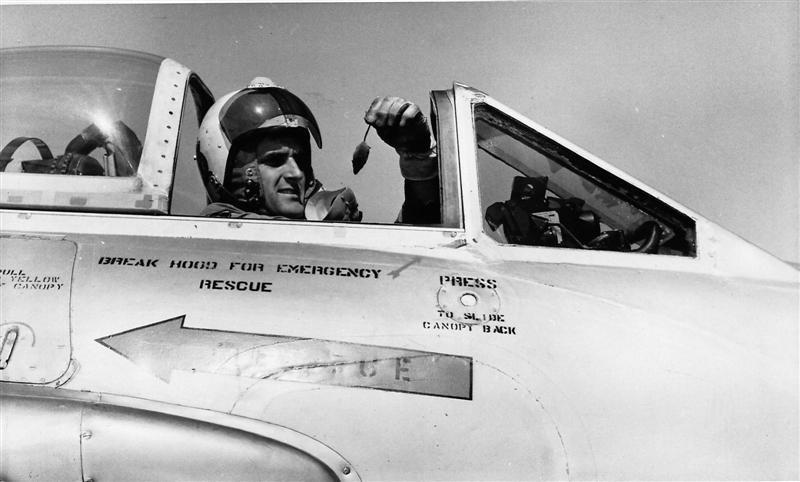
On February 16th 75 Sqn was involved for two weeks in ‘Exercise Bacchus’ providing air support to the NZ Army Annual camp. This involved with live FAC Strikes in D57 the Danger Area at Waiouru. The FAC would position in the area in his Harvard FAC aircraft and drop smoke bombs to identify the target to we ‘fighters’. We also flew air intercepts, weapons at Raumai, Navexs, instrument and formation flying to keep us on our toes. I did a long range drop tank cruise climb navex in Vampire T11 5707 where I climbed from Ohakea to Flight Level (FL) 250 [25,000 feet] enroute to Hamilton, FL 300 to Whakatane, FL320 to Gisborne, FL 340 to Napier, FL 360 to New Plymouth–Masterton-Wellington then back to top of descent point enroute to Ohakea – all in it took 2 hours 50 minutes, I hour 15 of which was in cloud.
On 31 Mar 1970 we deployed to ‘Ex Grey Warbler’ and were based at Whenuapai until 24 Apr 1970 while works were being carried out on the runway at Ohakea. This exercise involved FAC Strikes in the area north of Auckland in support of another FAC Course, plus weapons at D25 Kaipara range which is on the coast at the tip of the peninsula to the NW of Helensville. There was time for some low nav training as well – in FB5 5772 fitted with drop tanks I flew from Whenuapai to Dargaville, Kaitaia, Cape Kari Kari, Russell, Whangarei, Cape Rodney to Whenuapai. This took 1 hour 35 mins at 300 knots. With poor weather to the north of Whenuapai, simulated strikes were flown to the south of Auckland and rocketing attacks at D34 Volkner Island – a 1 hour 25 min mission in NZ5767 fitted with drop tanks that carried an extra 100 gallons of Avtur each.
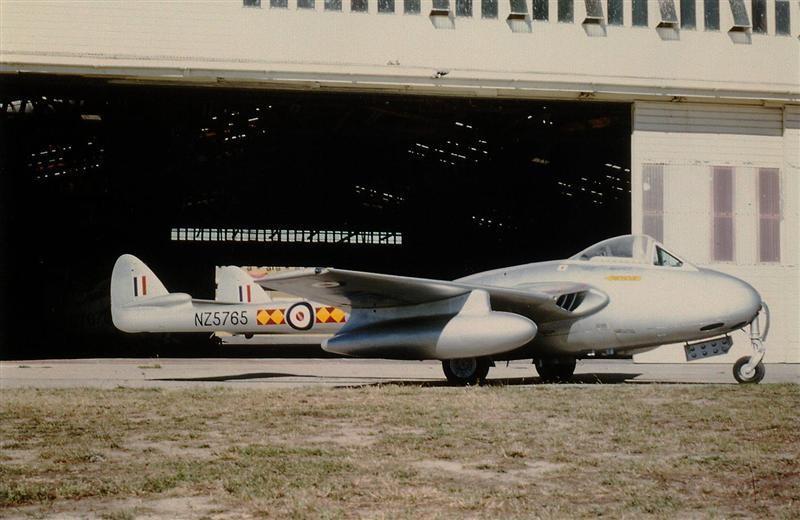

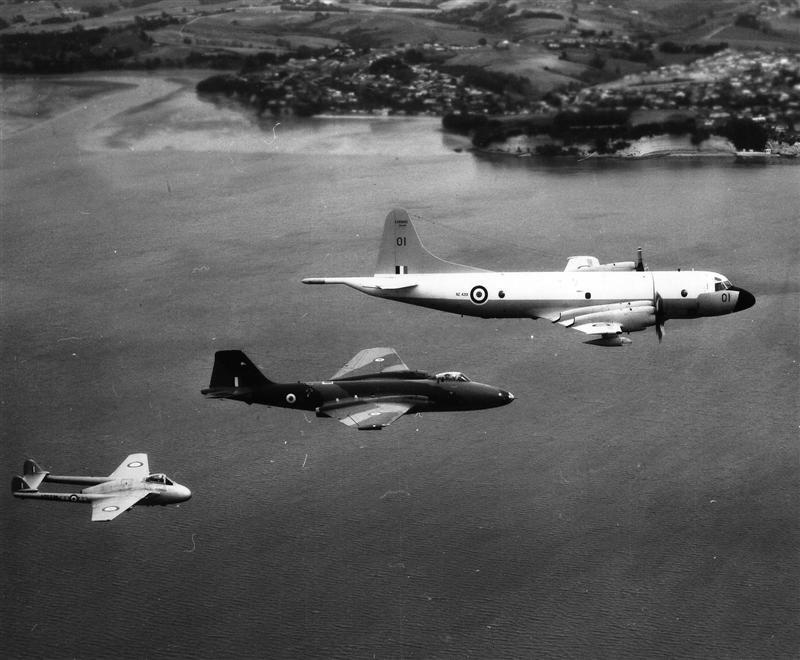
On 27 Apr 70 a 4 ship of Vampires met up with and then formated on the wing tips of an RNZAF C130 Hercules bringing the A4 Skyhawk trained crews back to Ohakea from USA. On 1 May 70, No 75 Vampire Sqn was renamed as Strike Support Unit (SSU) and the 75 Sqn number was passed to the new A4K Skyhawk Squadron. The 75 Sqn Skyhawk aircrew who had just returned to Ohakea awaited the arrival by sea of the Skyhawks.
At SSU we continued to fly the Vampires on the normal routine of air to air and air to ground flights. I was attached to 14 Canberra Sqn and left on 28 May 70 in a C130 Hercules to fly to Alice Springs and then on 29 May 70 to Changi in Singapore for ‘Exercise Bersatu Padu’. As an Operations Officer I was based at RAF Tengah in Singapore for what was to be the last big exercise by the British based Far East forces before they withdrew east of Suez. I managed to secure a ride in a Vulcan bomber. I saw RAF Lightning interceptor fighters, Singapore Armed Forces Hawker Hunters and RAAF Mirages defending Singapore against air attack by Canberra and Vulcan bombers. There were also interdiction and close air support flights from Tengah in support of NZ, Aust and Brit Army units in the Malaysian jungle. All good stuff for a relatively junior Vampire pilot to see. I returned to Ohakea 3 Jul 70 in a C130 loaded with kids toys, Noritake crockery, stereo set and all the other trappings a visit to Singapore brought.
Once Ex Bersadu Padu was over and the Canberras of 14 Sqn had returned to New Zealand, No 14 Canberra squadron disbanded and the aircraft and remaining aircrew were assigned to SSU. On the same date, 1 July 70, the Vampires of SSU became 14 Sqn. Just as he had earlier been as CO 75 Vampire Sqn, then CO SSU, Sqn Ldr Stew Boys retained command of the 14 Sqn Vampires. The Canberras were progressively ferried to India. In early July, I took T11 5710 to Woodbourne and carried out a test flight on FB5 5774 – an engine test, air frame test and stick force test before returning the next day to Ohakea in NZ5710. I did an interesting test flight on 14 Jul 70 on FB5 NZ5770 after the aircraft had had a severe overstress. I was set a maximum of 250 knots, 2g max, no negative g and max of 50 degrees of bank – I’m not sure what I could have done other than bale out, should the aircraft have broken up!
Another interesting flight I arranged was to be part of ‘Black formation’ on 14 Jul 70 to take ‘for the record’ some air-to-air photos of a formation comprising a retiring-from-service Canberra NZ6110 flown by Flt Lt Gavin Trethewey with Navigator Flt Lt Mike Hill, a Vampire FB5 NZ5772 flown by me – Fg Off Jim Barclay, and a new-to-service Skyhawk A4K NZ6201 flown by Fg Off Murray Abel. RNZAF photos G3/3659 and others record the historical occasion. Tragically, the very popular Murray Abel was to die of an aneurism in just a year or so.

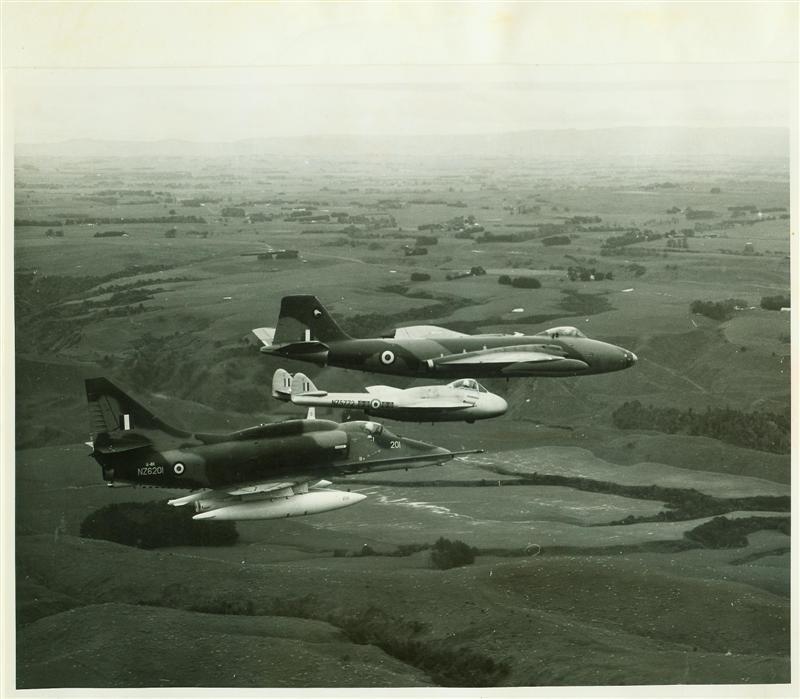
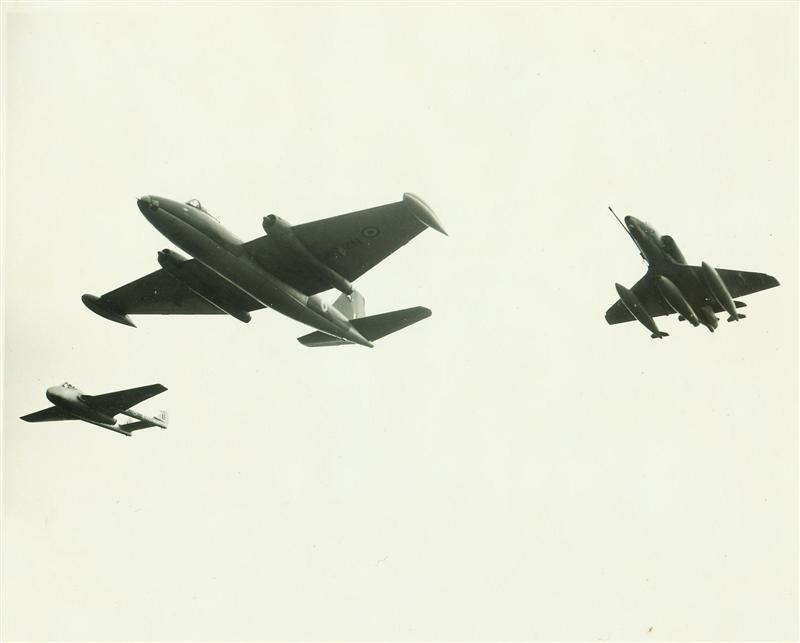
Also on 14 Jul 70 I flew to Woodbourne in T11 5710 to collect Flt Lt ‘Brick’ Lucas who had delivered a Canberra to Woodbourne for short term storage. Sadly, Brick was to loose his life in 1979 when, as one of two co-pilots, he was aboard the Air NZ DC10 that crashed into Mt Erebus.
On 17 Jul 70 I ferried the overstressed and damaged FB5 5770 to Woodbourne with in-flight restrictions, test flew FB5 5774 to find it still had problems with stick force reversal and returned to Ohakea in T11 5708 with Fg Off Graeme Bethell who had been sent to collect me. Keeping enough FB5 aircraft in the air was becoming a real problem as the flame cans in the centrifugal flow Goblin engines were disintegrating with advanced age and the RNZAF apparently had no spares. Cannibalisation between engines became a new word! Back to Woodbourne I went on 27 Jul 70 with Fg Off Rod Anyan in T11 5709, where I once again test flew FB5 5774 before flying it back to Ohakea. On 28 Jul 70 I took my former CO of Pilot Training Squadron, Sqn Ldr John Terry for a re-familiarisation flight and on 30 Jul 70 I took Wg Cdr Geoff Hubbard for two familiarisation flights before he went to the RAAF to evaluate their Macchi 326 jet trainer. Two more test flights were undertaken in FB5 5774 in an attempt to get the aircraft trimmed correctly so it would fly straight.
My final month flying the Vamps at Ohakea was in Sep ’70. We spent the month doing air-to air training – Cine ¼ attacks, Cine weave and air-to-air gunnery. A flypast in Palmerston North was undertaken by a 4 ship led by Flt Lt Gavin Trethewey. Previous experience had taught us that it would be much, much easier to have the parade Reviewing Officer, in this case the Mayor of Palmerston North, step up to the front of the dais exactly on time such that the flypast formation leader could have a finite time to be overhead. Gavin and I ran a practice the previous day – we ran-in several times from the holding point at Tokomaru heading northwards to the Square in order to get the time down to the exact second. On the day, we had the Mayor’s escort officer, Fg Off Mike Callanan of 75 Sqn, instruct the Mayor ‘to the micro second’ as to where he needed to be. After they had mounted the official platform and met the Councillors and other VIPs, Mike could see they were still a little early so the Mayor was told to “keep talking”, which he did until Mike said “turn around now”, then “walk forward now” whereupon the Parade Commander gave the command “General salute”. As the rifles of the 100 man parade clicked down into the ‘present’ position, the four Vamps screamed overhead, exactly on time. Perfect! The Parade Adjutant, later said he had never seen such precision and expert timing!
On 21 Sep 70 I led a two-ship ‘lo-nav’ sortie to Whenuapai in FB5 5772. I did another ‘lo nav’ as far north as Kaikohe in FB5 5774 and a Navy Co-op in FB5 5772 on 23 Sep 70 – all with drop tanks fitted. My final flight in a Vampire was on 25 Sep 70 when I flew back to Ohakea in T11 5709 with Fg Off Rod Anyan as passenger. We were number 2 in a 2 ship formation and so poor was the weather, I had to fly close formation all the way to a pairs touchdown on Runway 09 at Ohakea. The low cloud and rain meant that Gavin Trethewey led the flight as his Master Green Instrument rating allowed a lower Break off Altitude for the Precision Approach Radar (PAR) talk-down approach than did my White rating.
And so I finished my Vampire flying with 346 hours first pilot-day, 31 hours dual instruction-day, 9 hours first pilot-night and 2 hours 20 mins dual instruction-night. I now had a total of 390 hours on Vamps and a grand total of all flying amounting to 649 hours. I began Number 2 A4 Skyhawk Conversion Course with 75 Sqn in October 1970.
On Vampires, pilots got around 20 flights each per month. I averaged about 18.5 flying hours per month over the 21 months I was flying Vampires. To get more than 20 hours in a month was to be called an “Hour-Hog” – and lucky. Some sorties were as short as 10 mins in the case of ‘operational’ air-to-ground gunnery at Raumai where only 3 passes at the target were allowed while firing the 100 rounds of 20mm canon. Most flights were of 50 to 55 minutes, unless drop tanks were fitted when around 1 hour 30 mins could be flown at low level. The FB5s had five fuel gauges located around the base of the control column and it became a practiced art to total up the five bouncing fluctuating fuel gauges in one glance whilst flying close formation. The T11 had a single capacitor fuel gauge that was much easier to use – and so did FB5 5751. Such luxury. We started a flight with 330 gallons and due to inaccuracies in the fuel gauges we had to be on the ground at the end of a sortie with a minimum of 30 gallons of Avtur Jet fuel – one air traffic controller said we should call ‘Mayday’ before taxing as we were already short of fuel! Thirty gallons was enough for about 1 circuit – but then living on the edge was what fighter pilots were all about, wasn’t it ?!
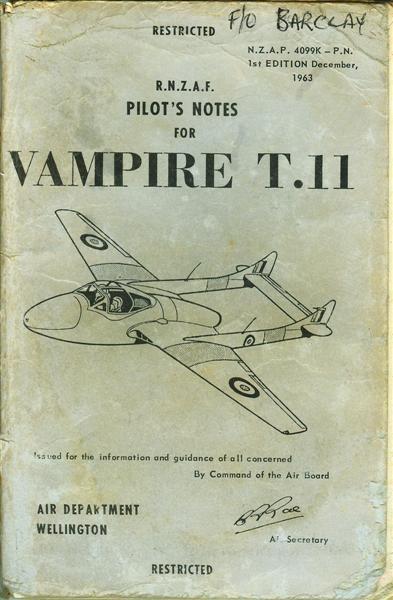
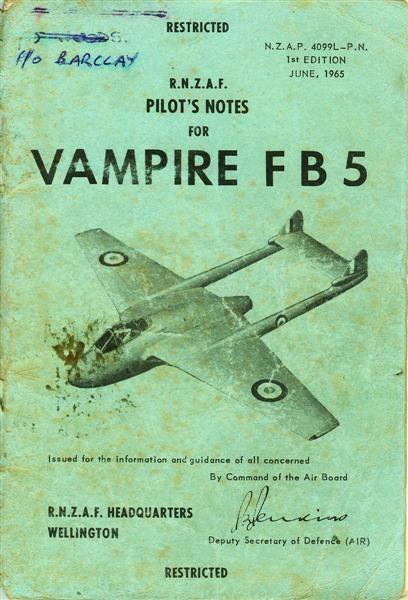
Flaps and Airbrakes were hydraulically actuated and there was a manual hand pump in the cockpit should the system fail. Wheel brakes were pneumatic and operated by a hand brake on the control column control with differential braking via the rudder pedals – the brakes were good for one landing run. An external starter trolley contained a number of big lead acid batteries and if these were not well charged, the engine would not accelerate on start-up so a ‘wet’ start resulted – this resulted in instructions to “Have the groundcrew depress the tail and remove any fuel from the jet pipe.” That is, push down on the tail booms to raise the nose of the aircraft and allow the unused fuel to drip out the back onto the ground. The cockpit was pressurised automatically after takeoff in the T11 but pilots had to remember to turn the canopy seal handle after takeoff in the FB5 or a fogged up canopy would result. Maximum speed was 0.76 Mach below 15,000 feet and 0.78M above, Maximum altitude 42,000 feet, Maximum takeoff weight 13,000lb, Maximum G +6 to -3.5g. Stall Turns and intentional spinning were prohibited. Speeds – takeoff speed 105K, stall speed 90K, Aerobatics – Roll 240K, Loop 320K, Roll off the top 340K, Vertical roll 340K plus, Circuit – downwind 160-140K @7000rpm undercarriage and flap down, Base turn 130K, touchdown 95K. The Vamp had a single VHF radio of 44 channels and a single frequency 118.1 VHF emergency/standby radio. It has one navigational aid – an ADF.
What did I think of the Vamp? It was a very good airplane in which to learn the basic skills required of a fighter pilot. It was smooth, light and nimble to fly and precise in air-to-air and air-to ground operations. This in turn allowed good use to be made of the Gyro Gun Sight (GGS) to achieve relatively accurate weapon scores. Always short of fuel, pilots needed to think quickly and make timely decisions in order to avoid to running out of gas. The flying was varied and interesting – a Boggie’s life on 75 Vamps was good! The Vamp set me up well to fly the A4K Skyhawk with 75 Sqn, and later, the Phantom F4E and D models on exchange with the USAF.
Vampires T11s I flew were 5707, 5708, 5709, 5710, 5711
Vampire FB5s I flew were 5751, 5755, 5765, 5767, 5770, 5772, 5774, 5776.
Vampire Pilots I flew with – in chronological sequence –
1966 – F/L Trev Band, F/L John Denton, F/O John Woolford, F/O Arthur Dovey, F/O Murray Whineray,
1967 – P/O Dave Bevan, F/O Geoff Ogilvie, F/O Peter Waller, S/L Barry Reid, S/L Colin Rudd
1969 – F/L Baden Pere, F/L Ken Gayfer, F/O Daryl McEvedy, Fg Off Dale Webb, S/L Ross Donaldson, F/O Ken Cox, F/O Graeme Thomson, F/O Rob Benton, F/L Roger Henstock, F/O Jim Jennings, P/O Ian Wood, S/L John Scrimshaw, P/O Graeme Bethell, F/L Ross Ewing, F/O Mike Callanan, Lt Cdr Fred Myers USN
1970 – P/O Ian Tennent-Brown, F/O Ian Renai, F/O Rod Anyan, P/O John Bates, F/L Brian Lockie, S/L Stewart Boys, P/O Ron Ferguson, F/L Gavin Trethewey


Guy Russell
Posted at 07:19h, 21 AprilHi Jim,
What a good read! I hope you write more stories about your adventures in the RNZAF!
I certainly enjoyed the two rides you gave me in the TA4K 😀
Jim Barclay
Posted at 09:24h, 22 AprilHi Guy,
Thanks for your comments. There will be more, but it takes time to sift through my computer to find and edit them before sending them to Nic to add to this website.
I have a few smaller stories, plus one on flying the F4E and D Phantom with the USAF, and a long one about flying the A4 Skyhawk in the early 1970s. However, the Skyhawk one will probably be a bit too technical for most, so will have appeal only to aviation buffs.
Keep smiling !
Jim
Nev Maw
Posted at 00:22h, 04 JuneA very good read. Brought back lots of memories.
Armourer on 75 Sqdr 68 to 70
Lucky enough to get 3 flights in a T11. Two with Pete Waller & one with Mike Callanhan. Never forget, great experience.
Jim Barclay
Posted at 08:58h, 04 JuneThanks Nev. I’m pleased the story brought back fond memories for you; we would have been on 75 Sqn Vampires at the same time (I was there on Vamps 1969/1970). Maybe we also shared the Quadrant Hut at Raumai Range, and some of the cook-ups you armorers provided (like curried possum!). Peter Waller lives at Red Beach, but sadly Mike passed away years ago. Cheers, Jim
Charlotte Bailey
Posted at 10:13h, 25 JanuaryNev – if I might ask, did you work as an armourer on the Vamps? If so, would I be able to contact you about a Vampire research project I’m undertaking?
There’s one T.11 left airworthy here in the UK, and I was fortunate to have had one flight. Also an unforgettable experience.
Cheers! Charlotte.
Supree
Posted at 15:23h, 06 OctoberAmazing jet airplane, Im proud my country bought them for the first jet warbird for our airforce before I born. I like historical warbirds. So I wanna make a miniature of the Vampire for my collection. Thanks for your writting Mr. Jim.
Paul Harrison
Posted at 12:14h, 03 JulyHi Jim,
Great memories! Keep them coming. I have just scanned quite a few of Maurice Conly’s (the Air force Artist) slide of Vampires, Canberras and Skyhawks of the 1969/70 era when he was tasked with some paintings of the Vampires and Canberras about to retire.
Can forward you some if you wish, great shots of weapons loads and maintenance hangar pics of them
cheers
Paul H
Jim Barclay
Posted at 14:33h, 03 JulyThanks Paul!
I remember Maurice being at Ohakea in that period capturing paintings of the last of the Canberras before they were phased out of service in the mid 1970s, capturing the new Skyhawks as they entered service from the mid 1970s, and capturing the enteral Vampires that were phased out when the Strikemasters replaced them in the early 1970s.
I would love to have some scans of Maurice’s colour slides – if you don’t mind emailing them to me?!
With thanks and kind regards,
Jim
Jason C Frear
Posted at 17:30h, 25 JanuaryGreat memories, Jim!